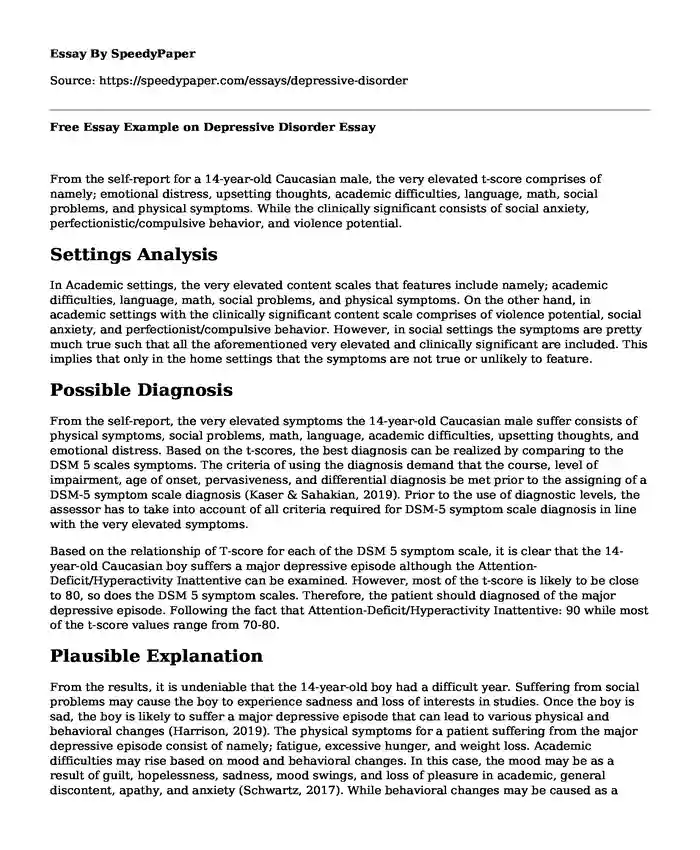
| Type of paper: | Essay |
| Categories: | Stress Depression Psychological disorder |
| Pages: | 3 |
| Wordcount: | 653 words |
From the self-report for a 14-year-old Caucasian male, the very elevated t-score comprises of namely; emotional distress, upsetting thoughts, academic difficulties, language, math, social problems, and physical symptoms. While the clinically significant consists of social anxiety, perfectionistic/compulsive behavior, and violence potential.
Settings Analysis
In Academic settings, the very elevated content scales that features include namely; academic difficulties, language, math, social problems, and physical symptoms. On the other hand, in academic settings with the clinically significant content scale comprises of violence potential, social anxiety, and perfectionist/compulsive behavior. However, in social settings the symptoms are pretty much true such that all the aforementioned very elevated and clinically significant are included. This implies that only in the home settings that the symptoms are not true or unlikely to feature.
Possible Diagnosis
From the self-report, the very elevated symptoms the 14-year-old Caucasian male suffer consists of physical symptoms, social problems, math, language, academic difficulties, upsetting thoughts, and emotional distress. Based on the t-scores, the best diagnosis can be realized by comparing to the DSM 5 scales symptoms. The criteria of using the diagnosis demand that the course, level of impairment, age of onset, pervasiveness, and differential diagnosis be met prior to the assigning of a DSM-5 symptom scale diagnosis (Kaser & Sahakian, 2019). Prior to the use of diagnostic levels, the assessor has to take into account of all criteria required for DSM-5 symptom scale diagnosis in line with the very elevated symptoms.
Based on the relationship of T-score for each of the DSM 5 symptom scale, it is clear that the 14-year-old Caucasian boy suffers a major depressive episode although the Attention-Deficit/Hyperactivity Inattentive can be examined. However, most of the t-score is likely to be close to 80, so does the DSM 5 symptom scales. Therefore, the patient should diagnosed of the major depressive episode. Following the fact that Attention-Deficit/Hyperactivity Inattentive: 90 while most of the t-score values range from 70-80.
Plausible Explanation
From the results, it is undeniable that the 14-year-old boy had a difficult year. Suffering from social problems may cause the boy to experience sadness and loss of interests in studies. Once the boy is sad, the boy is likely to suffer a major depressive episode that can lead to various physical and behavioral changes (Harrison, 2019). The physical symptoms for a patient suffering from the major depressive episode consist of namely; fatigue, excessive hunger, and weight loss. Academic difficulties may rise based on mood and behavioral changes. In this case, the mood may be as a result of guilt, hopelessness, sadness, mood swings, and loss of pleasure in academic, general discontent, apathy, and anxiety (Schwartz, 2017). While behavioral changes may be caused as a result of social isolation, restlessness, irritability, crying, and agitation. The academic performance in terms of language and math may be contributed by cognitive development or changes. The cognitive problems may be fueled by suicidal thoughts, slowness in activity, and lack of concentration.
By exploring the very elevated symptom, it is undeniable that the boy performance is indeed deteriorating based on the fact that he is a major depressive disorder patient. The disorder may exacerbate effects beyond the boy's emotions and mental health. In a real-life situation, the disorder may cause physical problems such as increased inflammation, weight changes, and chronic pain (Greer & Joseph, 2019). For these reasons, the boy is likely to face bad performance in school and social life.
References
Greer, T. L., & Joseph, J. K. (2019). Functional and Psychosocial Consequences of Major Depressive Disorder. Cognitive Dimensions of Major Depressive Disorder, 1-14. doi:10.1093/med/9780198810940.003.0001
Harrison, J. E. (2019). The Assessment of Cognitive Dysfunction in Major Depressive Disorder. Cognitive Dimensions of Major Depressive Disorder, 59-72. doi:10.1093/med/9780198810940.003.0006
Kaser, M., & Sahakian, B. J. (2019). Major Depressive Disorder as a Disorder of Cognition. Cognitive Dimensions of Major Depressive Disorder, 23-34. doi:10.1093/med/9780198810940.003.0003
Schwartz, T. L. (2017). Depressive Disorders: Major Depressive Disorder, Persistent Depressive Disorder, Premenstrual Dysphoric Disorder, and Seasonal Depressive Disorder. Practical Psychopharmacology, 158-218. doi:10.4324/9781315697383-5
Cite this page
Free Essay Example on Depressive Disorder. (2023, Feb 14). Retrieved from https://speedypaper.net/essays/depressive-disorder
Request Removal
If you are the original author of this essay and no longer wish to have it published on the SpeedyPaper website, please click below to request its removal:
- Law Essay Example: Rights of Federal Crime Victims
- The Impacts of Social Darwinism, Free Essay
- Essay Example: Controversial Actions of Ida B. Wells Jr, and Martin Luther King
- Essay Example Comprising the Critique of Supersize Me Documentary
- Marketing Essay Example: Target Markets for Specific Products
- Article Review Essay Sample: The Currency Exchange Rate Between the United States and China
- The Impacts of Artificial Intelligence - Essay Sample
Popular categories




